|
80x5 -
240x3 -
240x4 -
320x1 -
320x2 -
320x3 -
640x1 -
640x2
Set display option above.
Click on
images to enlarge. |
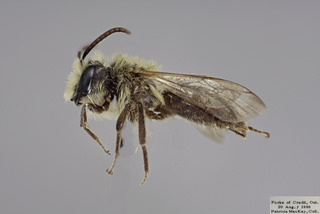
© Copyright Laurence Packer 2014
· 7
Andrena hirticincta MALE CFPcomp |
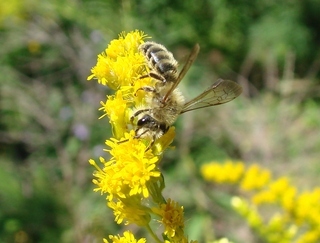
© Copyright John Ascher, 2006-2014
· 6
Andrena hirticincta, Hairy-banded Andrena mining bee |
|
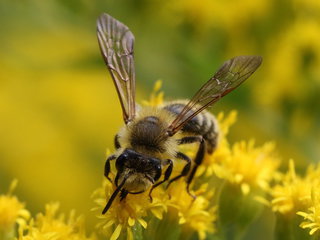
Michael Veit · 6
Andrena hirticincta, m on Solida -- |
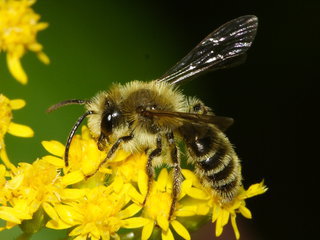
Michael Veit · 6
Andrena hirticincta, m |
|
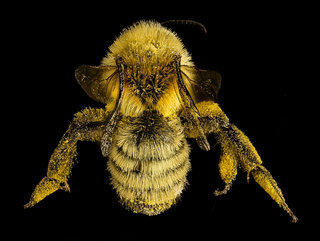
© Copyright source/photographer
· 5
Andrena hirticincta, f, back, Maine, Du Clos |
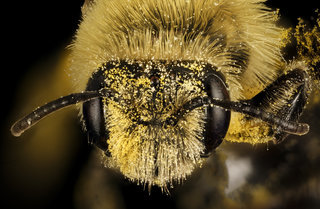
© Copyright source/photographer
· 5
Andrena hirticincta, f, face, Maine, Du Clos |
|
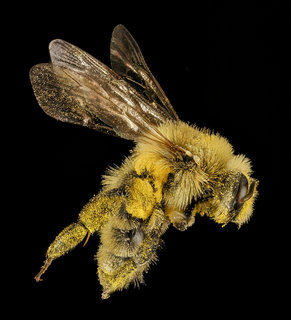
© Copyright source/photographer
· 5
Andrena hirticincta, f, side, Maine, Du Clos |
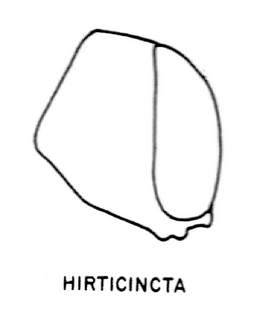
© Rebekah Andrus Nelson
· 2
Andrena hirticincta, male, cheek |
|
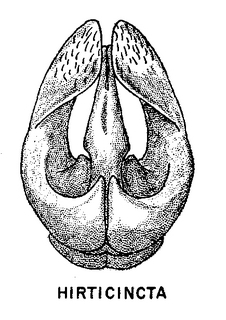
Mitchell, Bees of the Eastern United States, Vol. I, 1960 · 1
Andrena hirticincta, figure33c |
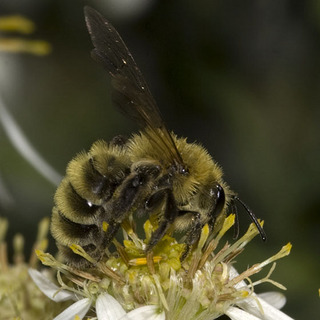
Steve Nanz · 1
Andrena hirticincta |
|
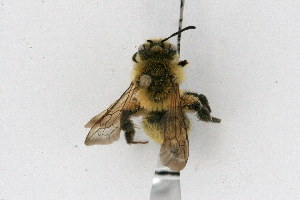
Barcode of Life Data Systems · 1
Andrena hirticincta, BArcode of Life Data Systems |
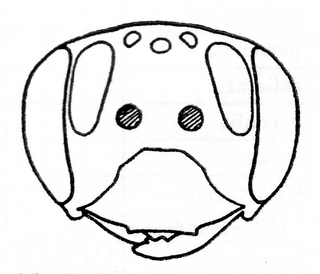
© Rebekah Andrus Nelson
· 1
Andrena hirticincta, female, face |
|
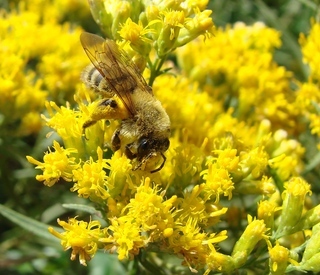
© Copyright John Ascher, 2006-2014
· 0
Andrena hirticincta |
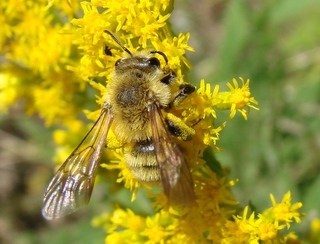
© Copyright John Ascher, 2006-2014
· 0
Andrena hirticincta |
|
Overview |
Reprinted by permission of the Regents of the University of California from:
Donovan, B. J. 1977. A revision of North American bees of the subgenus Cnemidandrena (Hymenoptera: Andrenidae). University of California Publications in Entomology: 1-107.
Please report text errors to: leah at discoverlife dot org.
This species is differentiated from other Cnemidandrena by the green-yellow tinge of most of its pubescence. The pointed lateral expansions of the penis valves in the male closely associate this species with A. colletina, but the general appearance of the pubescence of A. colletina is light yellow on the mesosoma and white on the metasoma. Andrena hirticincta is more distantly related to A. surda and A. luteihirta, the males of which have somewhat rounded lateral expansions of the penis valves, but the overall vestiture of these two species is yellow.
FEMALE. MEASUREMENTS AND RATIOS. — N = 20, length, 11.0-13.1 mm; width, 3.4-4.4 mm; wing length, M = 3.54 ± 0.184 mm; FL/FW, M = 0.96 ± 0.088; FOVL/FOVW, M = 2.55 ± 0.064.
INTEGUMENTAL COLOR. — Black except as follows: antenna red-brown ventrally beyond second flagellar segment, apical half of mandible red; tegula brown-yellow; wing veins red-brown; wing membrane hyaline except for apical area moderately darkened; tarsi, except basitarsi, light yellow-brown; tibial spurs light yellow; metasomal terga and sterna narrowly hyaline apically.
STRUCTURE. — Flagellar segments 1 to 3 equal in length to scape, flagellar segment 1 longer than flagellar segments 2 plus 3; flagellar segments 2 and 3 each shorter than succeeding segments. Eye more than 4 times as long as broad, with inner margin diverging very slightly above except for upper end incurved. Malar space short, more than 7.5 times wider than long. Mandible in repose extends for one-fourth its length beyond middle of labrum; notch of mandible tooth almost equidistant between middle of labrum and mandible apex. Galea moderately tessellate, lateral surface as broad as dorsal surface. Maxillary palpus projecting slightly beyond apex of galea, segmental ratio 0.9:0.9:0.8:0.8:0.6:0.7. Labial palpal segment 1 compressed laterally, curved basally, apical segment attached subapically, segmental ratio 1.5:0.7:0.4:0.6. Labral process more than twice as broad as long, apical emargination depth one-fourth length of labral process, apical third slightly reflexed. Clypeus slightly protuberant, extending below eyes for one-third its length; lower two-thirds with large, irregular punctures, except for narrow median area impunctate; whole surface shagreened. Supraclypeal area shagreened. Genal area twice as wide as eye with fine, irregular shagreening, surface shiny. Vertex above lateral ocellus less than 1.5 ocellar diameters with irregular shagreening. Face above antenna with longitudinal rugulae extending to just above lateral ocellus. Facial fovea 2.5 times as long as broad, wide above, narrowing below, extending dorsally to a line through middle of median ocellus, below to just below antennal fossa.
Pronotum with humeral angle moderately developed, humeral ridge weak, and absent where reached by pronotal suture; pronotum dorsally with fine, reticular shagreening; vertical rugulae above pronotal suture, reticular shagreening below. Remainder of mesosoma dorsally coarsely tessellate, dull, punctures prominent except on scutum and propodeal enclosure. Propodeal enclosure well defined, with a broad, longitudinal depression medially, irregular, longitudinal rugulae in anterior third. Mesepisternum moderately tessellate above, shagreened below with scattered prominent punctures; metepisternum shagreened, with punctures on dorsal posterior area. Mesobasitarsus strongly expanded medially, length less than 3 times width, narrower than metabasitarsus. Metabasitarsus strongly expanded basally, narrowed distally, nearly 3 times as long as broad. Wing with pterostigma linear, length 4 times width, vein 1st m-cu meets second submarginal cell slightly beyond middle.
Metasomal terga 1 to 5 moderately tessellate, dull in direct view; punctures on discs of terga 1 to 4 separated by 2 to 5 diameters, becoming closer on posterior margins of discs; anterior rim of punctures raised. Disc of tergum 5 with very large, deep punctures, crowded on posterior margin, anterior rim of punctures strongly thickened and raised. Pygidial plate V-shaped, anterior half with fine, closely set punctures, posterior half impunctate, lateral edges raised. Sterna shagreened, punctures smaller than those on terga; sternum 1 emarginate medially.
VESTITURE. — That of head, mesosoma, and metasomal terga 1 to 4 green-yellow. Tergal discs 1 to 4 with abundant erect hairs, long on tergum 1, shorter on posterior terga, becoming progressively recumbent apically, forming broad fasciae as wide as more exposed areas. Hairs of profemur and long, recurved hairs of trochanteral floccus white; remaining leg hairs white or brown-black to tibia, black beyond tibia. Terga 5 and 6 with dense, black, appressed hairs obscuring whole surface. Sternum 1 with long, black, erect hairs on median third; sterna 2 to 6 with short, white, thinly scattered hairs basally, long black hairs laterally forming subapical fimbriae; apical margins of sterna 2 to 5 with narrow apical fringes of short, white, appressed hairs.
MALE. MEASUREMENTS AND RATIOS. — N = 20; length, 8.5-10.1 mm; width, 2.3-3.1 mm; wing length, M = 2.80 ± 0.176 mm; FL/FW, M = 0.94 ± 0.086; FS1/FS2, M = 1.44 ± 0.114.
INTEGUMENTAL COLOR. — Black except as follows: antenna red-brown ventrally beyond 1st flagellar segment; mandible red in apical third; tegula and wing as in female; legs black or nearly black, tibial spurs light yellow.
Metasomal terga and sterna black or nearly red-brown; tergal and sternal apical margins moderately widely hyaline.
STRUCTURE. — Scape shorter than flagellar segment 1 to 3; twice as long as flagellar segment 1; flagellar segment 1 longer than flagellar segments 2 or 3. Eye more than 3 times as long as broad, inner margin diverging slightly above except for upper end incurved. Malar space 9 times wider than long. Mandible, galea as in female. Maxillary palpus projecting slightly beyond apex of galea, segmental ratio 0.6:0.8:0.6:0.6:0.7:0.6. Labial palpus as in female except basal segment less compressed laterally, segmental ratio 1.1:0.5:0.4:0.5. Labral process very strongly reflexed, half as long as broad, median emargination depth one-third length of reflexed area. Clypeus flat, extending less than half its length below eyes; dorsolateral margins with small punctures obscured by shagreening, remainder with large, irregular, close punctures. Supraclypeal area as in female. Supra-antennal area irregularly rugose with scattered, obscure punctures. Parocular area below antennal fossa with large punctures separated by 1 diameter, above antennal fossa with longitudinal rugulae obscuring scattered punctures. Vertex as in female. Genal area twice as wide as eye with fine, irregular shagreening, posterior median margin produced to a distinct angle.
Pronotum with humeral angle and ridge well developed; pronotum irregularly shagreened dorsally, longitudinally rugose laterally nearly obscuring pronotal suture; angle between pronotal ridge and pronotal lobe smooth, polished. Remainder of mesosoma sculptured as in female except as follows: scutellum shiny on anterior half; propodeal enclosure flat medially, propodeal lateral areas moderately tessellate; metepisternum finely tessellate dorsally.
Metasomal terga sculptured as in female but punctures smaller, apical margins more widely hyaline. Sterna as in female except for sternum 1 broadly emarginate apically, sternum 2 less so. Sternum 7 (fig. 103) with posterior median notch, short hairs apically. Sternum 8 (fig. 104) with apex truncate, hairs abundant on neck region but few on anterior basal area. Gonoforceps (figs. 100 to 102) in dorsal view obliquely flattened and expanded, hairs on apical two-thirds only; penis valves strongly expanded laterally to blunt processes, penis valve apices expanded, lobe-like.
VESTITURE. — Green-yellow except for brown to black hairs on tibiae and basitarsi. Hair on clypeus more dense than in female.
Metasomal terga as in female but fasciae less dense. Sterna with suberect, subapical fimbriae with hairs longest laterally on sterna 2 to 4.
VARIATION. — In both sexes a very few hairs on the extreme lateral margins of tergum 4 may be light brown. The propodeal enclosure can be flat. In males, black hairs may be present on all femora, tibiae and tarsi, or brown hairs only may be present on the metatibiae and metatarsi. The posterior median margin of the gena may vary from rounded to produced to a distinct projection. Bilateral variation can occur in the same specimen.
Reprinted with permission from: Mitchell, T.B. 1960. Bees of the Eastern United States. North Carolina Agricultural Experiment Station Technical Bulletin No. 141.
FEMALE. — Length 11 mm.; clypeus rather flat, projecting but little below suborbital line, closely and finely punctate beneath quite dense pubescence; facial foveae narrow, occupying above hardly more than half the space between eyes and lateral ocelli, covered with ochraceous tomentum; lateral ocelli separated from margin of vertex by a space somewhat greater than their diameter; cheeks subequal in width to eyes, smooth and very minutely punctate; malar space evident, but very short; basal segment of flagellum subequal to 2nd and 3rd combined; process of labrum broadly subtriangular, apex rather broadly emarginate; mandibles of ordinary length, with an inner, subapical tooth; pubescence of head, thorax and abdominal terga 1-4 bright ochraceous, long, dense and erect, that on legs including scopa largely black, and black on segments 5 and 6 and on venter of abdomen; thoracic integument dull, densely tessellate, without evident punctures; enclosure of propodeum smooth and densely tessellate; propodeal corbicula well developed, with a distinct anterior fringe, ochraceous; trochanteral floccus well developed; tibial scopa short, dense and black, of simple hairs; fore and hind basitarsi slightly narrower than their respective tibiae, the mid basitarsi fully as broad as their tibiae; 2nd submarginal cell somewhat shorter than 3rd, receiving 1st recurrent slightly beyond middle; abdominal terga tessellate and dull, punctures exceedingly minute, well separated, apical margin scarcely depressed, concolorous with remainder of discs, pubescence somewhat more dense apically to form obscure fasciae.
MALE. — Length 8-9 mm.; clypeus broad and flat, projecting but slightly below suborbital line, dull, very finely and closely punctate beneath dense pubescence; space between lateral ocelli and margin of vertex slightly exceeding their diameter; cheeks broad and flat, posterior margin subcarinate, not conspicuously angulate, with minute, well separated punctures; malar space short, barely evident; basal segment of flagellum slightly exceeding 2nd segment in length; process of labrum much broader than long, its truncate margin slightly emarginate; mandibles of moderate length, with a distinct, inner, subapical tooth, overlapping about one-third; pubescence of head, thorax and abdomen long, dense and erect, pale ochraceous throughout, that on legs largely pale, but becoming brownish on tibiae and tarsi; thoracic integument dull, densely tessellate, impunctate except for some very obscure, minute punctures on scutum anteriorly and pleura above; enclosure of propodeum smooth and tessellate; all basitarsi slender and elongate, narrower than their respective tibiae; 2nd submarginal cell much shorter than 3rd, receiving 1st recurrent slightly beyond middle; abdominal terga dull, tessellate, with rather close and exceedingly minute, obscure punctures, apical margins slightly depressed, becoming hyaline toward rims, where pubescence is somewhat more dense, to form rather conspicuous apical fasciae; apical portion of sternum 8 slender, elongate, sides nearly parallel, apex truncate; penis valves not expanded basally, gonocoxites moderately expanded apically, gonocoxal lobes moderately produced, subtriangular.
DISTRIBUTION. — Minnesota to the New England states and Nova Scotia, south to North Carolina and Georgia; August to October.
FLOWER RECORDS. — Aster and Solidago. Recorded by Brittain and Newton (1934) also on Epilobium.
|
|
|
Identification | |
Extracted from Joel Gardner. "The mining bees of Minnesota (unpublished manuscript)" Andrena hirticincta is the most common Cnemidandrena and also the most easily
recognized. Both sexes are completely covered in very long, dense, lemon-yellow hair, except
for the legs, which are black. They are often mistaken for small bumble bees. Andrena
hirticincta is oligolectic on Solidago and Euthamia.
|
|
|
Names | |
|
|
| Supported by | |
Updated: 2024-04-23 17:38:20 gmt
|